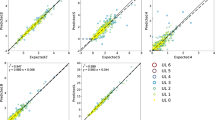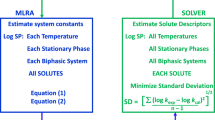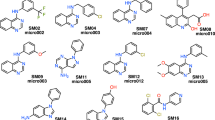Abstract
To predict the 1-octanol/H2O partition coefficient, log P, based on molecular structures, we calculated the solvent accessible surface area and the solvation energy difference of 166 organic molecules between 1-octanol and water environments with the ab initio molecular orbital self-consistent reaction field method, and then analyzed the relationships among the measured log P values with these two structural quantities by multiple linear-regression analyses. Physicochemically meaningful correlations were obtained, suggesting that non-hydrogen bonding and hydrogen-acceptor molecules behave similarly to each other in partitioning, but that hydrogen-donor molecules behave differently from the former molecules. The results provide a new computational approach for predicting log P.
Similar content being viewed by others
References
C. Hansch and A. Leo, “Exploring QSAR: Fundamentals and Applications in Chemistry and Biology”, 1995, American Chemical Society, Washington, D.C.
J. L. M. Hermens and H. J. M. Verhaar, “Classical and Three-Dimensional QSAR in Agrochemistry”, ed. C. Hansch and T. Fujita, 1995, Chap. 10, American Chemical Society, Washington, D.C.
L. G. Danielsson and Y.-H. Zhang, Tr. in Anal. Chem., 1996, 15, 188.
H. Tanaka, T. Tachibana, and H. Chuman, Anal. Sci., 2001, 17, i1403.
H. Tanaka, Y. Yamamoto, and H. Chuman, Anal. Sci., 2002, 18, 485.
C. Hansch and A. Leo, “Exploring QSAR: Fundamentals and Applications in Chemistry and Biology”, 1995, Chap. 4–4–2, American Chemical Society, Washington, D.C.
A. Klamt and G. Schüürmann, J. Chem. Soc. Perkin Trans. 2, 1993, 2, 799.
A. Klamt, V. Jonas, T. Burger, and J. C. W. Lohrenz, J. Phys. Chem., 1998, 102, 5074.
C. Yamagami, K. Kawase, and T. Fujita, Quant. Struct-Act. Relat, 1999, 18, 26.
C. Yamagami and T. Fujita, J. Pharm. Sci., 2000, 89, 1505.
O. Tapia and O. Goscniski, Molecular Physis, 1975, 29, 1653.
C. Hansch, A. Leo, and D. Hoekman, “Exploring QSAR: Hydrophobic, Electronic, and Steric Constants”, 1995, American Chemical Society, Washington, D.C.
Gaussian, Inc., Pittsburgh, USA, 1999.
A. D. Becke, J. Chem. Phys., 1993, 98, 5648.
M. Cossi, V. Brone, R. Cammi, and J. Tomasi, Chem. Phys. Lett, 1996, 255, 327.
A. Bondi, J. Phys. Chem., 1964, 68, 441.
C. Chothia, Nature, 1974, 248, 338.
T. Fujita, T. Nishioka, and M. Nakajima, J. Med. Chem., 1977, 20, 1071.
Author information
Authors and Affiliations
Corresponding author
Rights and permissions
About this article
Cite this article
Chuman, H., Mori, A. & Tanaka, H. Prediction of the 1-Octanol/H2O Partition Coefficient, Log P, by Ab Initio MO Calculations: Hydrogen-Bonding Effect of Organic Solutes on Log P. ANAL. SCI. 18, 1015–1020 (2002). https://doi.org/10.2116/analsci.18.1015
Received:
Accepted:
Published:
Issue Date:
DOI: https://doi.org/10.2116/analsci.18.1015




